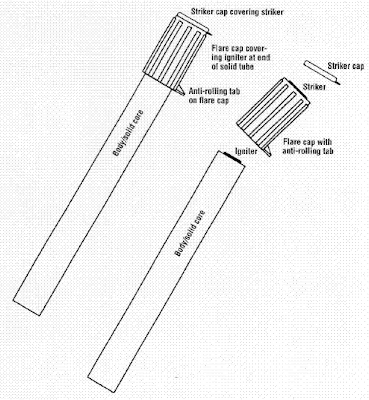A road flare is made up of: Flare cap, Striker cap, Striker, Body/solid core, Igniter, Stand, Pull strip, and Hollow tube.

In general the road flares when used, will last for about 10, 15, 20, or 30 minute. The time duration will be noted on the flare being used in your department. If the use is for a longer term emergencies it will require re-lighting additional road flares or even considering cones, signs, and barriers. Alerting the caution to warn traffic of hazard at hand is important to set-up as soon as possible to protect those or traffic control fire fighters and EMS personnel working the emergency scene.
 Safety should always be in play when using road flares. A road flares burn at approximately 1400 degrees F. Phosphorus is the main chemical and vapors are toxic. You should avoid breathing any fumes. Flares will splatter or sometimes shoot particles of hot burning phosphorus. Contact with water can cause small explosive-like reactions. Use gloves and eye protection when igniting and extinguishing road flares. Keep bare skin covered use PPE.
Safety should always be in play when using road flares. A road flares burn at approximately 1400 degrees F. Phosphorus is the main chemical and vapors are toxic. You should avoid breathing any fumes. Flares will splatter or sometimes shoot particles of hot burning phosphorus. Contact with water can cause small explosive-like reactions. Use gloves and eye protection when igniting and extinguishing road flares. Keep bare skin covered use PPE.
To ignite/light road flares grasp flare with either hand near base with gloves on and goggles/face shield in place. With free hand grasp and remove flare cap, twist either direction, exposing igniter. Remove striker cap, place thumb under edge, force upward Exposing striker. Place igniter and striker of flare together, with exposed igniter in one hand and flare cap with exposed striker in the other. Ignite flare with hands fully ex- tended from body, eyes turned away from flare and striker. Rapidly rub striker across igniter with movement of flare away from the body. Repeat striking until flare is ignited. Hold ignited flare at arm's length from body, pointed away from body. DO NOT look directly at flame and DO NOT inhale toxic smoke.
Should road flares be held by emergency responder to direct traffic? No, and is a bad idea due to the burn injury hazard. Hot phosphorus could land on or in passing vehicles. Hot phosphorus can easily burn through clothing, even safety turnouts, and can cause severe burns
If raining, flare should not be set straight up, as raindrops hitting burning end directly can cause splattering of hot phosphorus (up to 20 feet). Due to cylindrical shape, flares may: Roll, be blown away by air currents from passing vehicles, be accidentally kicked, or be run over by vehicles requiring concern for where the flare may roll (Dry Vegetation, Fuel Sources, etc.)
To overcome these problems by carefully placing flares, constantly watch their placement, chock with rocks if you need to. Some flares have a plastic tab that prevents them from rolling. To utilize the "Anti-Rolling Tab," place the flare cap on the non-burning end of the flare after ignition. A wire stand can be used to hold the flare in place.

Avoid looking directly at flame for any length of time. Extreme brightness may damage or impair vision. Do not throw a burning flare down, impact on burning end may or will cause explosive-like reaction. Burning particles will scatter many feet.
To safely extinguish road flare you should: Find an area void of vegetation. Grind flare into ground rotating clockwise and counterclockwise. If necessary, use a small amount of water to assure complete extinguishment. It may be necessary to extinguish
road flare slag as well.
Emergency Responders that’s use road flare on an emergency scene of a MVA on the roadways & highways need to be wearing those neon safety vests that will help keep fire fighters and EMS personnel safe. Also, continuously do “Your Own 360” scene safety while performing, because being safe is just plan good, common sense.


No comments:
Post a Comment